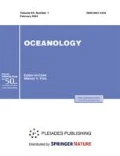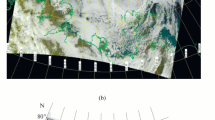Abstract—
The article considers a particular event in the influence of a mesoscale cyclone (MC) on the northern Sea of Japan on February 10–11, 2013. The passage of the MC was accompanied by a sharp increase in wind to storm conditions, an almost twofold decrease in total heat transport, and a fourfold increase in the momentum flux. Perturbations of the hydrological characteristics in the wake of the MC estimated from data of two Argo floats were traced to a depth of 300 m off the west coast of Hokkaido and up to ~100 m in the deep-water region, caused by the difference in the background stability of the vertical structures. Several estimates of the contribution of various factors to the observed variability of the upper sea layer are given.





Similar content being viewed by others
REFERENCES
Hydrometeorology and Hydrochemistry of the Seas, Vol. 8: The Sea of Japan, No. 1: Hydrometeorological Conditions, Ed. by A. S. Vasil’ev, et al. (Gidrometeoizdat, St. Petersburg, 2003) [in Russian].
R. G. Grigorkina and V. R. Fuks, Impact of Typhoons on an Ocean (Gidrometeoizdat, Leningrad, 1986) [in Russian].
I. A. Gurvich, Intensive Mesoscale Cyclones over Far Eastern Seas, Part 1: The Structure and Characteristics of Mesoscale Cyclones According to Multisensor Satellite Measurements (Pacific Oceanological Institute, Far Eastern Branch, Russian Academy of Sciences, Vladivostok, 2017) [in Russian].
I. A. Gurvich and M. K. Pichugin, “Characteristics of intensive mesoscale cyclones over Far Eastern seas based on satellite multisensor sounding,” Sovrem. Probl. Distantsionnogo Zondirovaniya Zemli Kosm. 10 (1), 51–59 (2013).
E. V. Zabolotskikh, L. P. Bobylev, A. V. Dikins, et al., “Specific formation and classification of storm mesoscale eddies,” Uch. Zap. Ross. Gos. Gidrometeorol. Univ., No. 16, 59–76 (2010).
E. V. Zabolotskikh, I. A. Gurvich, and B. Chapron, “New areas of polar lows over the Arctic as a result of the decrease in sea ice extent,” Izv., Atmos. Oceanic Phys. 51, 1021–1033 (2015).
E. I. Lutsenko and V. E. Lagun, “Polar mesoscale cyclones in atmosphere over the Barents and Kara seas,” Probl. Arkt. Antarkt., No. 2 (96), 76–89 (2013).
V. A. Luchin, “Seasonal dynamics of water temperature in active layer of Far Eastern seas,” in Far Eastern Seas of Russia (Nauka, Moscow, 2007), Book 1, pp. 232–252.
V. V. Moroz, “Characteristics and formation conditions of water structure in the La Pérouse Strait and adjacent water basins,” Etestv. Tekh. Nauki, No. 10 (88), 230–233 (2015).
E. S. Nesterov and A. A. Lukin, “Extreme waves in the North Atlantic,” Russ. Meteorol. Hydrol. 37, 728–734 (2012).
P. P. Niiler and E. B. Kraus, “One-dimensional models of the upper ocean,” in Modeling and Prediction of the Upper Layers of the Ocean, Ed. by E. B. Kraus (Pergamon, New York, 1977; Gidrometeoizdat, Leningrad, 1979).
A. A. Nikitin, G. I. Yurasov, and N. S. Vanin, “Satellite observations of synoptic eddies and the geostrophic circulation of the Sea of Japan waters,” Izv., Atmos. Oceanic Phys. 48, 980–992 (2012).
Processing of Oceanographic Station Data (UNESCO, Paris, 1991; UNESCO, Sevastopol, 1993).
M. S. Permyakov, D. A. Akmaykin, P. A. Salyuk, et al., “Influence of typhoons on phytoplankton chlorophyll fields as revealed from SeaWiFS data,” Earth Obs. Remote Sens. 5, 56–62 (2005).
M. S. Permyakov, T. I. Tarkhova, D. V. Burov, et al., “Perturbations of the surface temperature field during the passage of a tropical cyclone over the Sea of O-khotsk,” Sovrem. Probl. Distantsionnogo Zondirovaniya Zemli Kosm. 4 (1), 332–336 (2007).
M. S. Permyakov, T. I. Tarkhova, and E. Yu. Potalova, “ Tropical cyclones of the northwestern part of the Pacific Ocean and their impact on the waters of the Far Eastern seas,” in Far Eastern Seas of Russia (Nauka, Moscow, 2007), Book 1, pp. 97–111.
M. S. Permyakov, T. I. Tarkhova, and A. S. Sergienko, “Estimates of the characteristics of the horizontal turbulent exchange in the northwestern part of the Pacific Ocean,” Oceanology (Engl. Transl.) 47, 647–652 (2007).
E. Yu. Potalova, T. I. Tarkhova, and M. S. Permyakov, “Estimates of tropical cyclone effects on the upper layer in the seas of Japan and Okhotsk,” Russ. Meteorol. Hydrol. 32, 224–228 (2007).
P. A. Salyuk, I. E. Stepochkin, A. I. Aleksanin, and I. A. Golik, “Analysis of the impact of tropical cyclones on the concentration fields of chlorophyll a in the northwestern part of the Pacific Ocean using passive satellite data survey in 1979–1986 and 1996–2010,” Sovrem. Probl. Distantsionnogo Zondirovaniya Zemli Kosm., No. 2, 219–227 (2014).
T. I.. Tarkhova, M. S. Permyakov, and A. S. Sergienko, “Some characteristics of small-scale atmosphere-ocean interaction in tropical cyclones,” Russ. Meteorol. Hydrol., No. 11, 45–50 (2002).
N. D. Tilinina, S. K. Gulev, and A. V. Gavrikov, “Formation of extreme surface turbulent heat fluxes from the ocean to the atmosphere in the North Atlantic,” Oceanology (Engl. Transl.) 56, 1–5 (2016).
F. Chen and H. von Storch, “Trends and variability of North Pacific polar lows,” Adv. Meteorol. 2013, 170387 (2013). https://doi.org/10.1155/2013/170387
C. de Boyer Montégut, G. Madec, A. S. Fischer, et al., “Mixed layer depth over the global ocean: An examination of profile data and a profile-based climatology,” J. Geophys. Res.: Oceans 109, C12003 (2004). https://doi.org/10.1029/2004JC002378
D. P. Dee, et al., “The ERA-Interim reanalysis: Configuration and performance of the data assimilation system,” Q. J. R. Meteorol. Soc. 137, 553–597 (2011). https://doi.org/10.1002/qj.828
V. W. Ekman, “On the influence of the earth’s rotation on ocean currents,” Ark. Mat. Astr. Fys. 2 (11), 1–52 (1905).
W. G. Large, J. C. McWilliams, and P. P. Niiler, “Upper oceanic thermal response to strong autumnal forcing of the northeast Pacific,” J. Phys. Oceanogr. 16, 1524–1550 (1986).
W. G. Large and S. Pond, “Open momentum flux measurements in moderate to strong winds,” J. Phys. Oceanogr. 11, 324–336 (1981).
O. Saetra, T. Linders, and J. B. Debernard, “Can polar lows lead to a warming of the ocean surface?” Tellus A 60, 141–153 (2008).
F. Sakaida, H. Kawamura, and Y. Toba, “Sea surface cooling caused by typhoons in the Tohoku Area in August 1989,” J. Geophys. Res.: Oceans 103, 1053–1065 (1998).
S. I. Watanabe, H. Niino, and W. Yanase, “Climatology of polar mesocyclones over the Sea of Japan using a new objective tracking method,” Mon. Weather Rev. 144, 2503–2515 (2016). https://doi.org/10.1175/MWR-D-15-0349.1
W. Yanase, H. Niino, S. I. Watanabe, et al., “Climatology of polar lows over the Sea of Japan using the JRA-55 reanalysis,” J. Clim. 29, 419–437 (2016). https://doi.org/10.1175/JCLI-D-15-0291.1
ACKNOWLEDGMENTS
The authors are grateful to Cand. Sci. I.A. Gurvich and Cand. Sci. N.I. Rudykh (Ilyichev Pacific Oceanological Institute, Far Eastern Branch, Russian Academy of Sciences) for consultations and assistance with information on the MC.
Funding
The work was conducted in accordance with the theme 0271-2019-0011 of the Program of Fundamental Research of Russian Academy of Sciences.
Author information
Authors and Affiliations
Corresponding author
Additional information
Translated by E. Morozov
Rights and permissions
About this article
Cite this article
Potalova, E.Y., Kleshcheva, T.I. & Permyakov, M.S. A Mesocyclone over the Northern Sea of Japan in February 2013. Oceanology 59, 814–822 (2019). https://doi.org/10.1134/S0001437019060183
Received:
Revised:
Accepted:
Published:
Issue Date:
DOI: https://doi.org/10.1134/S0001437019060183



